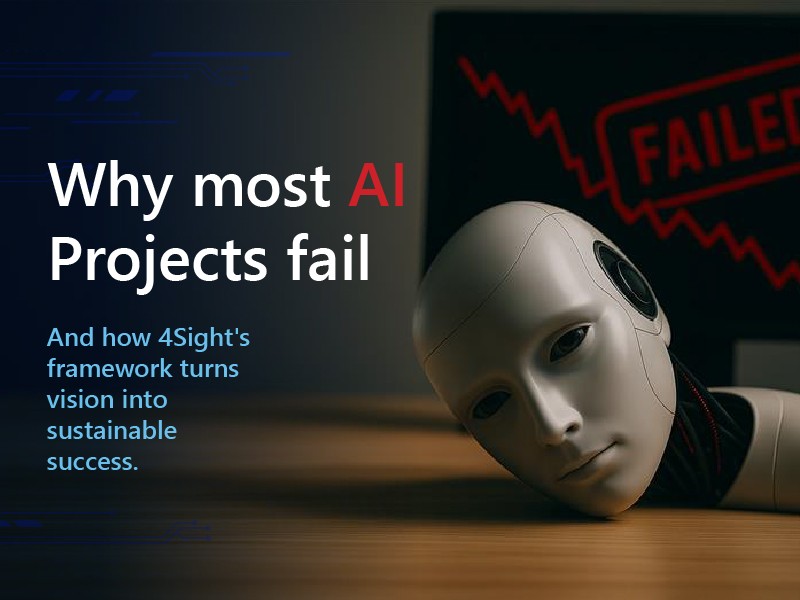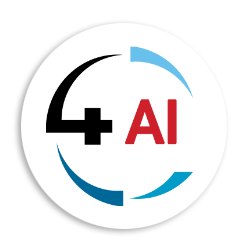Blog
Bridging the Strategic Gaps in Your AI Journey

Why Most AI Projects Fail – and How Our Framework Turns Vision into Sustainable Success
Too often, companies focus on automating existing processes or chasing quick wins, without rethinking their strategy from the perspective as an AI-driven business. They choose to utilise AI to digitise fax machines in a smartphone world – an outdated approach that yields only incremental improvements. The result: sub-optimal returns, stalled projects, or innovation efforts that never quite get off the ground.
The core issue is that leadership and strategy haven’t caught up with technology (AI in this case). Some of the gaps we typically see with organisations:
- Outdated Vision – Companies stick to old process paradigms and AI is applied in a very limited way, aiming to speed up existing tasks rather than reimagining them. It’s the “horse cart vs. automobile” problem. Simply automating a process with AI is nice, but rethinking an entire service offering or productis the game-changer.
- Data and Silo Issues – Even the smartest AI solution will underperform if it only has access to fragmented or poor-quality data. Its cliche, but many organisations still have data (AI's lifeblood) locked in departmental silos or legacy systems.
- Isolated POCs with No Clear ROI – It’s common to see isolated Proof-of-Concept projects (pilots) that show a cool demo or a slight efficiency gain, but have no clear link to business value or scale-up plan. A team might build an AI model that optimises one step of a process, but nobody calculated how that improves the bottom line or fits into a bigger roadmap.
- Losing Momentum After Pilot – Even when an AI pilot succeeds, many organisations hit a wall moving from pilot to production. This Transformation Momentum Loss can be a result of the next steps weren’t planned, the team not preparing the organisation for change, or governance that wasn’t in place to manage risksas initial excitement fizzles out.
These gaps are prevalent, but they’re addressable. It requires stepping back and treating AI initiatives not just as tech deployments, but as strategic transformation programs.
The 4AI Catalyst Framework:
A Map for AI-Driven Transformation To ensure AI projects deliver real value, we developed the 4AI Catalyst Framework – a structured approach that guides an organisation’s AI journey end-to-end. Think of it as a roadmap covering four critical pillars of success:
1. AI Maturity Diagnostic: Start by knowing your current state. We conduct a thorough audit of your current landscape– data quality, technology stack, processes, and people skills. How ready is your infrastructure for AI? Are your data sources integrated or siloed? What processes are good candidates for AI, and which might break if automated?
- Key Outputs: This diagnostic identifies the gaps and opportunities upfront as well as a clear picture of your AI readiness and a list of pain points to tackle (e.g., a low “data health” score might highlight the need to unify customer data from different systems).
2. AI Business Strategy: Define where you want to go and why. Here we align AI initiatives with business objectives. We ask: "How can AI drive competitive advantage for you?" This isn’t about tech for tech’s sake; it’s about finding high-impact use cases and building a solid business case for it. We also help design an ethical AI framework and governance model so AI efforts align with your values and risk tolerance.
- Key Outputs: An strategic AI roadmap and investment plan. For example, you might decide to focus on an “autonomous supply chain agent” if you’re in retail, with projected savings and revenue uplift quantified. We ensure every proposed AI project has a clear value metric (revenue growth, cost savings, customer experience improvement, etc.) and KPIs.
3. AI & Digital Transformation Execution: Laying the groundwork to execute and scale. This pillar is about converting strategy into action. We create a detailed capability and technology roadmaps to guide what platforms or tools to implement, what data integrations to do, and in what sequence over a set timeline. We craft a change management plan so that people in your organisation are ready to work with the new AI solutions.
- Key Outputs: A step-by-step execution plan and architectural blueprint, ensuring that when you deploy AI, it fits seamlessly into operations and people actually use it. This stage also implements guardrails (for example, human-in-the-loop checkpoints or compliance checks) to manage risks as you scale up the speed and autonomy of systems.
4. Future-Ready Leadership & Culture: Ensuring the organisation’s mindset evolves with the tech. This pillar involves coaching leaders, upskilling teams, and fostering an innovative culture. We brief executives on emerging AI trends relevant to them, run leadership workshops, and help set up governance structures like AI councils or champion networks.
- Key Outputs: Your leadership has the insight and confidence to drive AI initiatives, and your workforce is engaged rather than fearful. Over time, this creates a culture where AI is embraced as a co-worker, not seen as a threat or a fad. This is crucial for sustaining momentum beyond the first few projects.
These four pillars cover planning, strategising, executing, and leading – together addressing the technical and human factors of AI transformation. We also emphasize a “Catalyst” approach within the framework: rather than a big-bang overhaul, we often start with a targeted high-impact project (a Catalyst POC) that can demonstrate value quickly.
Importantly, the 4AI Catalyst Framework is modular and flexible. If you’ve already done a lot of groundwork on data, we can focus more on strategy and leadership. If you have visionary leadership but lack an execution plan, we zero in on the roadmap and quick wins. It’s not one-size-fits-all; it’s a scaffold you can adapt to your context, ensuring all critical bases are covered.
How This Framework Closes the Gaps (and Delivers Value):
Let’s circle back to those strategic gaps and see how a structured approach fixes them:
- Reimagining Strategy (Filling the Vision Gap): Through the AI Business Strategy pillar, we force a shift from narrow automation to innovative use of AI. Instead of “How can we use AI to speed up Task X,” we ask “With AI capabilities, what new outcomes can we achieve that were impossible before?” The ideal is to rethink business models to create an competitive edge.
- Unified Data and Tech Foundations: The AI Maturity Diagnostic and subsequent transformation roadmap directly tackles the data disconnect problem. We map out where data is siloed and integrate it as part of the plan (e.g., connecting your CRM, ERP, and supply chain data into a unified cloud platform). One deliverable might be a data integration blueprint or even a new data lake.
- ROI-Driven Projects (Aligning POCs with Strategy):Using strategic prioritisation and ROI analysis in the framework, every pilot is tied to a clear business case. We develop an AI investment portfolio that highlights which projects have the highest strategic value and ROI potential. So instead of a scattershot approach, you might focus on, say, three key initiatives: one to drive revenue, one to cut costs, one to improve customer loyalty – each with defined success metrics. No more “interesting demo, now what?” syndrome.
- Sustaining Momentum and Adoption: Through the detailed execution roadmaps and change management, the framework ensures there is always a “what’s next” after a pilot. We plan rollouts, training, and hand-holding beyond the prototype. And by coaching leaders and involving them throughout, we create accountability and enthusiasm at the top to keep pushing forward.
Conclusion:
By identifying and addressing the strategic gaps – from vision and data to ROI and adoption – companies can break out of pilot purgatory and scale AI in a meaningful way and to ultimatley build a business that’s smarter, faster, and more adaptive.
Ready to move from pilot to transformation?
📩 Get in touch at This email address is being protected from spambots. You need JavaScript enabled to view it. – let’s explore how we can add value to your AI journey.


